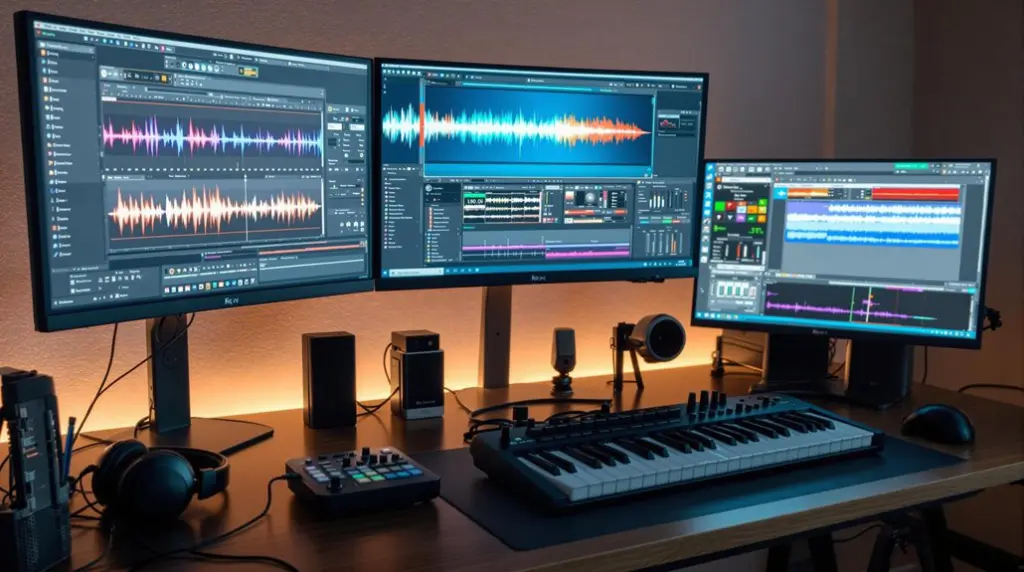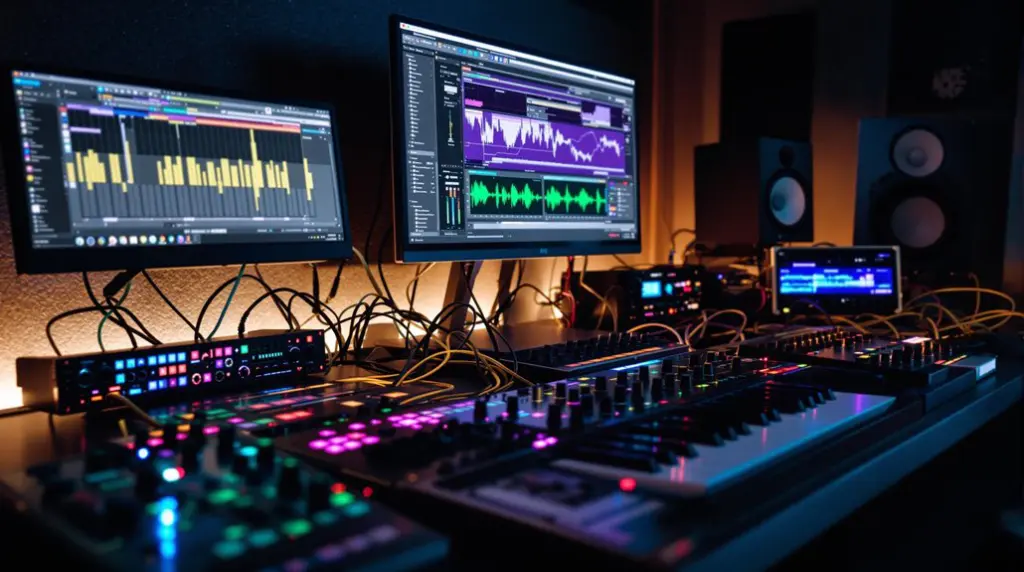For music production with Ableton, you need the best audio interface for Ableton to guarantee low latency and impressive fidelity. Consider the Focusrite Scarlett 2i2 for its Air Mode, enhancing clarity, or the Audient iD4 MKII, which boasts Class A preamps and swift USB 3.0. Universal Audio’s Apollo Twin X stands out with its real-time DUO Core processing. Also, check out the SSL 2+ for its analog warmth with the 4K Legacy mode. Connectivity options like USB, Thunderbolt, and Firewire significantly impact your setup’s efficiency and reliability. Choosing the perfect model hinges on aligning these features with your specific production needs. Further insights await to optimize your creative journey.
Key Takeaways
- Focusrite Scarlett 2i2 (4th Gen) enhances recordings with its Air Mode feature, ideal for Ableton.
- Audient iD4 MKII offers superior preamps and USB 3.0, ensuring low latency.
- Universal Audio Apollo Twin X includes a DUO Core Processor for efficient real-time tracking.
- SSL 2+ provides distinctive 4K Legacy mode, mimicking SSL 4000 series console sound characteristics.
- Compatibility, latency, and connectivity should be carefully considered to match production needs and budget.
Understanding Audio Interfaces
Audio interfaces, essential tools in music production, connect to your computer to enhance audio quality and expand input/output capabilities. Understanding the basics of these devices is important for selecting the right interface for your setup. They primarily function by converting analog audio signals into digital data, facilitating high-quality recording and playback through software like Ableton Live.
When choosing an audio interface, you’ll need to take into account several factors detailed in comparison charts. These include the number of inputs and outputs, the quality of preamps, connectivity options (such as USB, Thunderbolt, or FireWire), and supported sample rates. Higher sample rates and better preamps will provide clearer, more accurate sound reproduction, essential for professional results.
Troubleshooting tips are also essential as issues may arise with installation or during use. Common problems include driver conflicts, connectivity issues, or latency. To address these, make sure your interface’s drivers are up to date and compatible with your operating system. Adjust buffer sizes to reduce latency and check cable connections if experiencing audio dropouts or distortions.
Essential Features for Ableton
As you explore audio interfaces for use with Ableton, compatibility should be your primary concern; it guarantees that your hardware seamlessly integrates with the software.
In addition, you’ll need an interface that offers low latency performance, which is critical for maintaining real-time responsiveness during recording and playback.
These technical specifications are pivotal in ensuring that your creative workflow remains uninterrupted and efficient.
Compatible Connectivity Options
For ideal integration with Ableton, you’ll need an audio interface that features low-latency USB or Thunderbolt connectivity. Here’s a detailed connectivity comparison to aid your interface selection:
- USB vs Thunderbolt: Thunderbolt interfaces offer faster data transfer rates, greatly reducing latency. This difference in performance guarantees that Thunderbolt is better suited for real-time applications in Ableton.
- Widespread Compatibility: USB interfaces provide broad compatibility with numerous devices, making them a versatile choice for most setups.
- Firewire Option: Although not as common, Firewire interfaces are still viable for professional studios requiring stable audio performance.
- Impact on Music Production: Your choice between these connections directly impacts the efficiency and reliability of your music production tasks.
Low Latency Performance
Building on connectivity, low latency performance stands out as an important feature for Ableton users, ensuring immediate feedback during live recording and playback. Audio interfaces equipped with advanced DSP technology facilitate near-zero latency, essential for real-time monitoring and fluid signal processing.
Opt for interfaces that utilize Thunderbolt connections, as they offer superior data transfer rates, greatly reducing latency, especially in large projects. High-quality AD/DA converters are essential for minimizing latency, enhancing your overall production experience.
Additionally, consider interfaces with loopback features, which allow you to route audio internally, ideal for live streaming or podcasting without latency disruptions.
Prioritize hardware optimization and latency reduction techniques to achieve the best results in your music production workflow.
Top 7 Recommended Models
You’ll often find that the best audio interfaces for Ableton users combine high-quality preamps with low-latency performance. Delving into audio interface comparisons and user reviews helps you understand which ones rise above the rest for your music production needs. To enhance your Ableton Live experience, integrating these tools with music production tips from Ableton Live tutorials can greatly refine your workflow.
Here are four outstanding models that stand out:
- Focusrite Scarlett 2i2 (4th Gen) – Known for its Air Mode, this model enhances high-end presence beautifully, perfect for capturing vocals and acoustic instruments.
- Audient iD4 MKII – Features Class A console mic preamps, housed in a robust, compact frame. Its USB 3.0 connectivity ensures minimal latency, important for seamless recording sessions.
- Universal Audio Apollo Twin X – Equipped with a DUO Core Processor, it allows for real-time tracking with UAD plug-ins, offering a studio-grade recording environment.
- SSL 2+ – This interface brings SSL 4000 series console characteristics into your home studio with its 4K Legacy mode, adding analog warmth and depth to digital recordings.
Choosing the right audio interface involves weighing these features against your specific production requirements and budget.
Setting Up Your Interface
Once you’ve selected a suitable audio interface, connect it to your computer using the correct cable—USB, Thunderbolt, or Firewire—to begin setup. This initial step is vital in the interface setup process. After establishing a physical connection, the next critical task is to install the necessary drivers. These drivers guarantee your interface communicates effectively with your computer and Ableton, reducing the chances of connection problems.
If you encounter issues during this phase, checking for the latest driver updates can offer quick solutions. Manufacturers frequently release updates to enhance compatibility and performance. It’s essential to confirm that your audio interface is set as both the input and output device in Ableton’s preferences. This configuration is key to routing the audio correctly through your setup.
Should you face any troubleshooting scenarios, such as the interface not appearing in Ableton, double-check the entire signal path from connection to software settings. Often, re-installing drivers or rebooting your system resolves these glitches. Remember, a precise and methodical approach in setting up your interface lays the groundwork for a stable production environment, minimizing potential technical disruptions during your creative process.
Optimizing Interface Performance
How can you enhance your audio interface’s performance for best use with Ableton Live? Optimizing your setup isn’t just about choosing the right gear; it’s also about tweaking the settings to make sure you’re getting the best possible output. Here are some critical considerations:
- Low Latency Drivers: Make sure your interface has drivers optimized for low latency with Ableton Live. This minimizes delay during recording and playback, important for real-time applications.
- High-Quality Preamps: Use interfaces equipped with premium preamps. This ensures that the full dynamic range of your instruments and vocals is captured, which is essential for maintaining quality in your Ableton projects.
- High-Resolution Converters: Opt for interfaces that feature high-resolution converters to preserve the fidelity of your audio signals. This is crucial when working in a digital audio workstation (DAW) like Ableton Live to maintain audio integrity.
- Solid Clocking Mechanisms: Choose interfaces with robust clocking mechanisms. Accurate clocking is important to sync audio perfectly within Ableton Live, ensuring seamless performance and recording.
Troubleshooting Common Issues
When you encounter connectivity problems with your audio interface, it’s important to test different USB or Thunderbolt ports and cables to determine the root cause.
If you’re experiencing audio dropouts, adjusting the buffer size in Ableton Live can greatly enhance audio performance and reduce latency issues.
For issues related to driver installation, make sure that your drivers aren’t only up to date but also correctly configured to support seamless integration with Ableton Live.
Solving Connectivity Problems
To effectively address connectivity problems with your audio interface, first confirm it’s properly connected to your computer using USB, Thunderbolt, or another compatible port. Here’s a precise guide to enhance your troubleshooting techniques and guarantee ideal connectivity solutions:
- Update Drivers: Make sure your audio interface drivers are current and compatible with your operating system to avoid any conflicts.
- Check Cable Connections: Experiment with different USB or Thunderbolt ports to identify any potential hardware compatibility issues.
- Configure Software: Verify that Ableton Live recognizes your audio interface in its preferences and that input/output settings are correctly configured.
- Restart Devices: Sometimes, simply restarting both the audio interface and your computer can resolve transient connectivity issues.
Addressing Audio Dropout
Audio dropouts frequently disrupt your Ableton sessions, primarily due to insufficient system resources like CPU or RAM. To combat this, you’ll need to fine-tune your buffer size settings—an important step for buffer size optimization. Increasing the buffer size can alleviate the load on your CPU, greatly reducing dropouts during complex sessions. However, be mindful that higher buffer sizes may increase latency, impacting real-time monitoring.
To further minimize CPU usage, make sure you deactivate unnecessary background applications that consume system resources. By streamlining your operating environment, you enhance Ableton’s performance, facilitating smoother playback and latency reduction. Keep these adjustments balanced to maintain a responsive setup while preventing audio interruptions in your creative flow.
Fixing Driver Installation Issues
After addressing audio dropouts by optimizing your buffer settings, you might still encounter issues if your audio interface drivers aren’t installed correctly. Driver troubleshooting and firmware updates are vital to guaranteeing your setup works seamlessly.
Here’s how to tackle installation troubleshooting effectively:
- Download the Latest Drivers: Always fetch the most recent drivers from the manufacturer’s website for your specific model to guarantee compatibility and performance.
- Uninstall Previous Drivers: Remove any existing drivers and associated software before installing the new ones to avoid conflicts.
- Verify Installation: Use the device manager to check if the audio interface is recognized and properly installed.
- Disable Interferences: Temporarily turn off any antivirus or firewall software during the installation to prevent potential conflicts.
Remember to restart your computer after installation to apply changes and check configuration settings.
Expanding Your Setup
Consider exploring your Ableton Live setup by adding a MIDI controller to streamline your music production workflow. MIDI integration allows you to control hardware synths and other external gear seamlessly, merging the digital and analog worlds. This synergy not only enhances live performance flexibility but also enriches your studio environment.
Furthermore, incorporating external hardware synthesizers or drum machines introduces a tactile element to your creative process. By interfacing these devices with Ableton, you leverage the software’s robust processing capabilities while harnessing the unique sonic characteristics of hardware instruments.
To expand the sonic possibilities further, delve into Ableton’s extensive library of built-in audio effects and instruments. Utilizing these tools, you can sculpt and enhance your sound palette extensively. Additionally, experimenting with Max for Live devices opens up avenues for customizing and creating bespoke tools tailored to your specific production needs.
Lastly, connecting multiple audio interfaces can significantly boost your input/output capacity. This setup ensures seamless integration with Ableton Live, facilitating a more efficient and flexible recording environment. This approach not only accommodates larger projects but also simplifies complex routing scenarios essential for advanced production techniques.
Frequently Asked Questions
What Is the Best Audio Interface for Ableton?
The best audio interface for Ableton prioritizes low latency performance and driver stability, ensuring seamless integration. Look for models with high-quality preamps, multiple I/O options, and robust build for peak functionality.
What Is the Best Interface for Home Studio 2024?
For your home studio in 2024, consider the Focusrite Scarlett 2i2 for budget-friendly, space-efficient recording. It offers high-quality preamps and features like Air Mode to enhance your vocal and instrument tracks.
What Is the Best Professional Audio Interface?
The best professional audio interface guarantees robust interface durability and extensive connectivity options. It ensures peak performance with high-speed Thunderbolt or USB-C, precise A/D conversion, and versatile I/O configurations for demanding setups.
Why Is the Apollo Twin so Expensive?
The Apollo Twin’s high cost is due to its superior hardware quality, including elite-class AD/DA conversion, and advanced connectivity options like Thunderbolt 3, ensuring fast data transfer and low latency.
Conclusion
As you explore the top audio interfaces for Ableton, be sure to prioritize core features that enhance your workflow. Confirm compatibility and stability with your setup to optimize performance.
Tackle common issues by keeping firmware and drivers updated. As you expand, consider interfaces that offer scalability.
By carefully selecting and maintaining your audio interface, you’ll enhance your production capabilities, guaranteeing a seamless and efficient creative process in your music-making endeavors.




